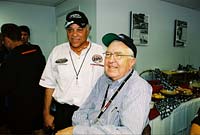|

Shelby ditched his Dallas dump truck business
in the late 1940s and took up raising chickens.
His first batch of broilers made him a $5,000
profit -- no chicken feed by 1949 standards
-- but he declared bankruptcy when his second
group of chickens died from Limberneck disease.
"I'd been a chicken farmer. All my chickens
died," Shelby said. "I was looking for something
else to do. And I decided I'd always loved cars.
So I tried to see if I could make it as a professional
racing driver. And three years later I was driving
for the factories in Europe."
Shelby, like Force, knows how it feels to hear
people laugh and not know whether it's with
you or at you. But both have used that to their
advantage as marketing tools. Force is legendary
for his rambling but entertaining monologues.
His trademark sooty fire suit, though, is no
match for Shelby's early racing attire. One
day in August 1953, Shelby realized that he
didn't have time to change clothes before heading
to the track. So he wore his striped bib overalls,
splattered with flecks of chicken manure. He
credits colorful Texas sports editor Blackie
Sherrod with putting his picture in the newspaper
because of his unique sense of fashion.
(Then again, Shelby always had gone by instinct
and done things his unique way. When he was
an Air Force pilot during World War II and flew
training missions out of Lackland Air Force
Base near San Antonio, he would correspond with
fiancée Jeanne Fields by sneaking love letters
into his flying boots, then once he was up in
the air, dropping his missives onto her family's
farm on flyovers. It won the girl -- they were
married in December 1943.)
Shelby also won in his first attempt behind
the wheel, driving a hot rod with a flathead
Ford V8 in January 1952. And that May, he had
traveled up to Norman, Okla., for his first
road race and driven his MG-TC to victory against
other MGs. That same day, against stiffer competition
from Jaguar XK 120s, he won again. Soon after,
he won an early SCCA event on a road-racing
course set up near tiny Cadd Mills, Texas, driving
a Cad-Allard. So he was building a winning reputation.
But people couldn't look past his clothing.
And so, as Shelby sat in the air-conditioned
tower at Gainesville Raceway -- a luxury he
earned by his own achievements and not some
corporate canonization -- he clearly was not
done analyzing. This was his first visit to
a drag race outside of Pomona, Calif., and the
West Coast in nearly 20 years. He squinted his
pale blue eyes slightly, not because his vision
was poor. Instead, he was sizing up the considerable
crowd, one of the best in recent times at the
Gatornationals, and enjoying the energy.

"Look at these kids, sitting out in the sun
all day long," he said. "Never move. Hell, they
even hate to go to the bathroom." He smiled
a satisfied smile, as if to say that in this
day of computers, hand-held computer games,
cell phones, CD players, and various other technological
distractions, he was pleased that motorsports
still could command the attention of busy and
choice-riddled America. On a gloriously hot
spring day, no less, these fans ignored the
media's college-basketball over hype and chose
to spend a full day at the drag races, on metal
bleachers, even though nitro-class drivers were
having a hard time hooking up with the track
and regrettably not giving them their best show.
For Shelby, it was reassurance. He knew the
show -- his show, motorsports, still had that
appeal.
And he attributed much of that to John Force,
whom he considers much more than the driver
of the Castrol Ford Mustang Funny Car or the
owner of three Mustangs in the class. He said
he regards Force as the glue that holds NHRA
together.
"Force makes this sport with all his bullshit,"
Shelby said approvingly. Shelby also visited
in the Gainesville Raceway suite with Don "The
Snake" Prudhomme, a relentless, cutting-edge
driver he sponsored back in the day, and called
him "a class act," adding, "I just think the
world of him." But he said of Force. "He's really
a class guy, too. This sport's really a hell
of a lot better off because of him. But it's
not bullcrap, really. You think he's just carrying
on like an idiot. And it all makes sense. He's
a wonderful spokesman for the sport. He's one
of the reasons it's growing as fast as it is."
The Sport Compact Series has intrigued Shelby.
And because he has made his mark by thinking
globally, he doesn't see a threat to the domestic
market. "Drag racing is what a lot of them can
afford to get into," he said of the young racers
today. "You know we're here for big-time today,
but these little pocket rockets, they get 100,000
people out there at Palmdale (Calif.) on Friday
and Saturday for these kids to run those little
front-wheel-drive cars. They're running 175
miles an hour in the quarter-mile. You think
of the technology that it takes for these kids
to take a gearbox that's built for 100 horsepower
and take one of these little Hondas or Toyotas
or Focuses or whatever it is and run 1,000 horsepower
through that thing. You talk about innovation
of the hot-rodders in the '30s -- it's nothing
compared with what thousands of these kids are
able to do today."

|